Abstract
IgM nephropathy (IgMN) causes nephrotic syndrome and is characterized by IgM mesangial deposits. It is speculated that these deposits are derived from circulating IgM aggregates or immune complexes, either of which would have a molecular weight heavier than that of normal IgM. To test this hypothesis the sera of 11 patients with IgMN, five patients with nephrotic syndrome of other etiologies, and 13 normal controls were analysed for such heavy IgM. The serum samples were passed over a Biogel A5M molecular sieve column and the fractions were tested for IgM concentration by enzyme linked immunosorbent assay (ELISA). The column effluent from the void volume to the IgM peak was divided into four equal regions, and the average IgM concentrations in each region were compared. The IgMN group had significantly higher IgM concentrations than normal controls in the heaviest region (0.81 +/- 0.84 vs. 0.32 +/- 0.17 micrograms/ml; P = 0.01) and in the lightest region (95.8 +/- 59.5 vs. 46.3 +/- 41.2 micrograms/ml; P = 0.02). Although the IgMN group appeared to have about double the IgM levels of the nephrotic control group in all four regions, this was only significant in the lightest (19S) region. In serum samples from two IgMN patient methods known to break antigen antibody bonds eliminated the heavy IgM; in one case we used gel filtration in potassium thiocyanate and in another ultracentrifugation at pH 2.8. In addition, the heavy IgM in this second patient exhibited complement fixation activity in a sandwich ELISA for IgM-C3 complexes. We conclude that IgMN patients have circulating heavy IgM, which by preliminary studies probably consists of complement fixing IgM immune complexes.
Full text
PDF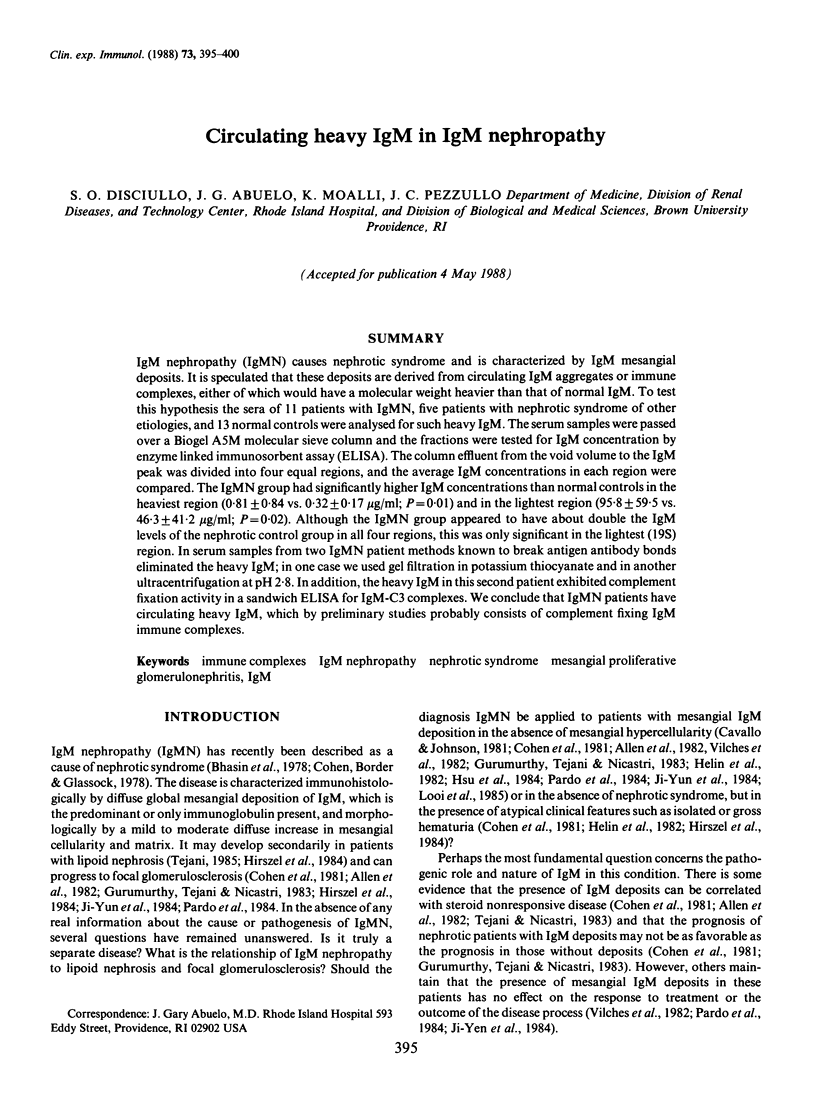
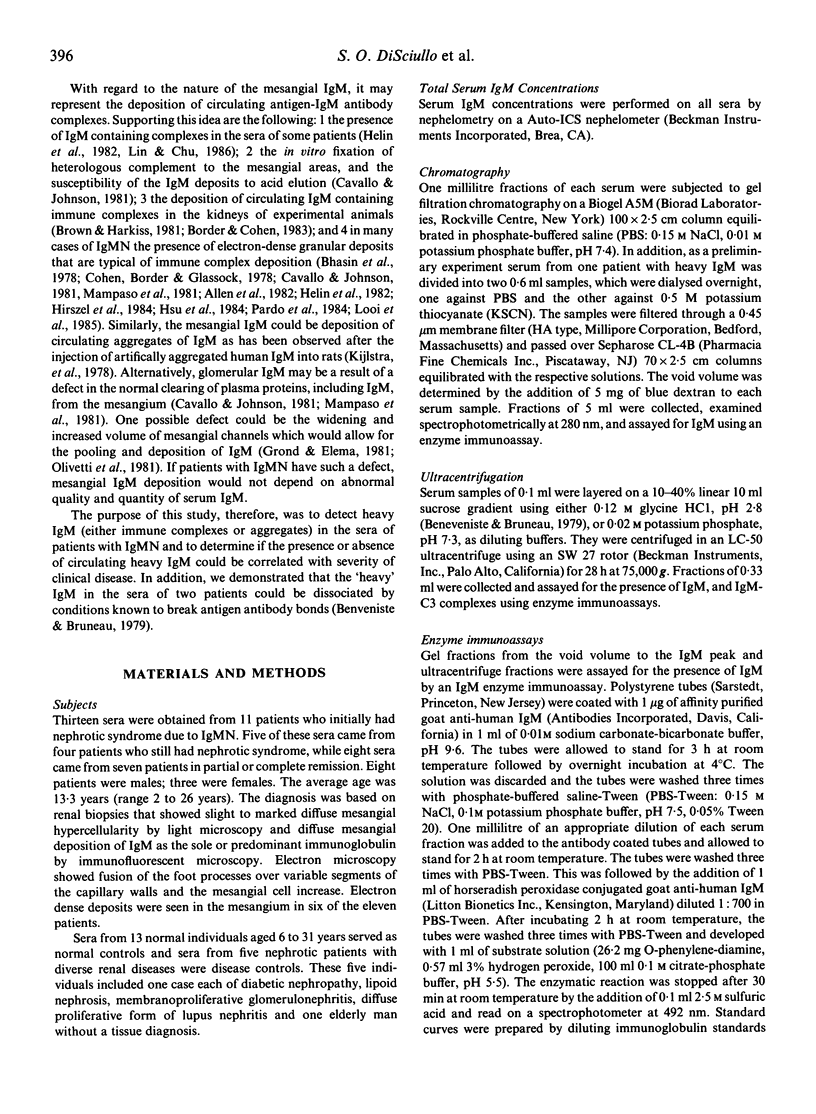

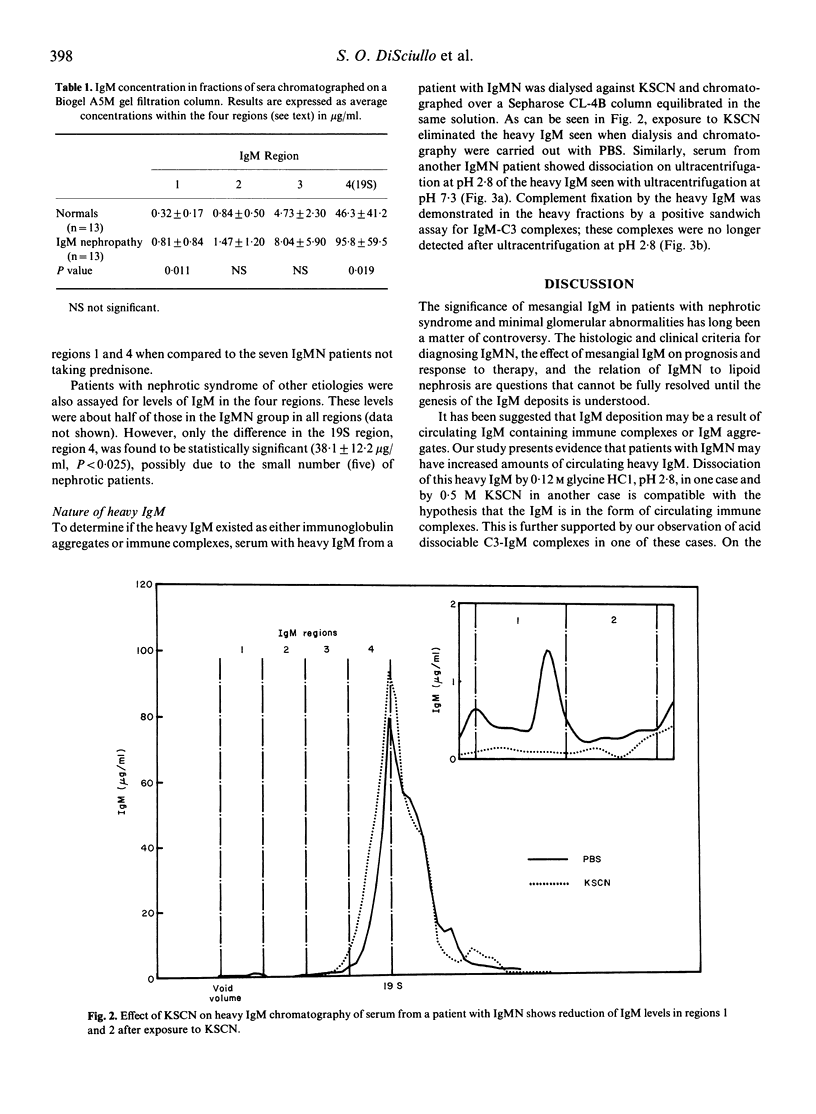
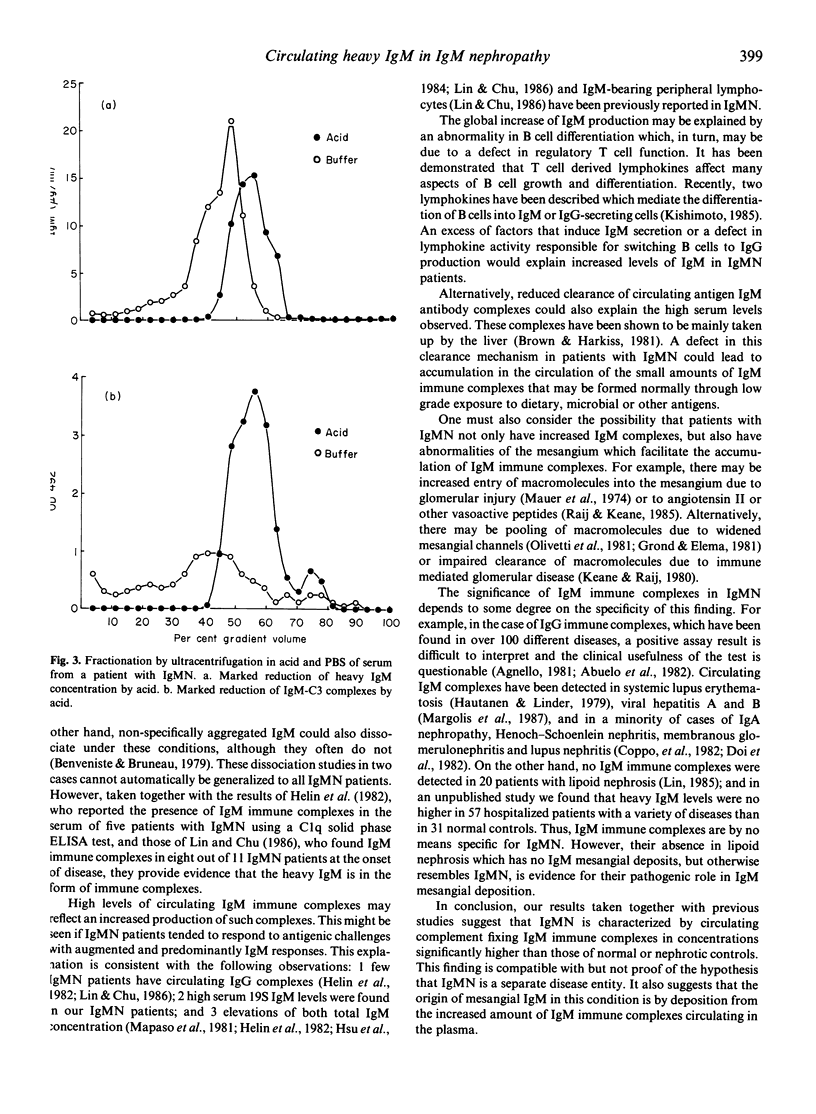
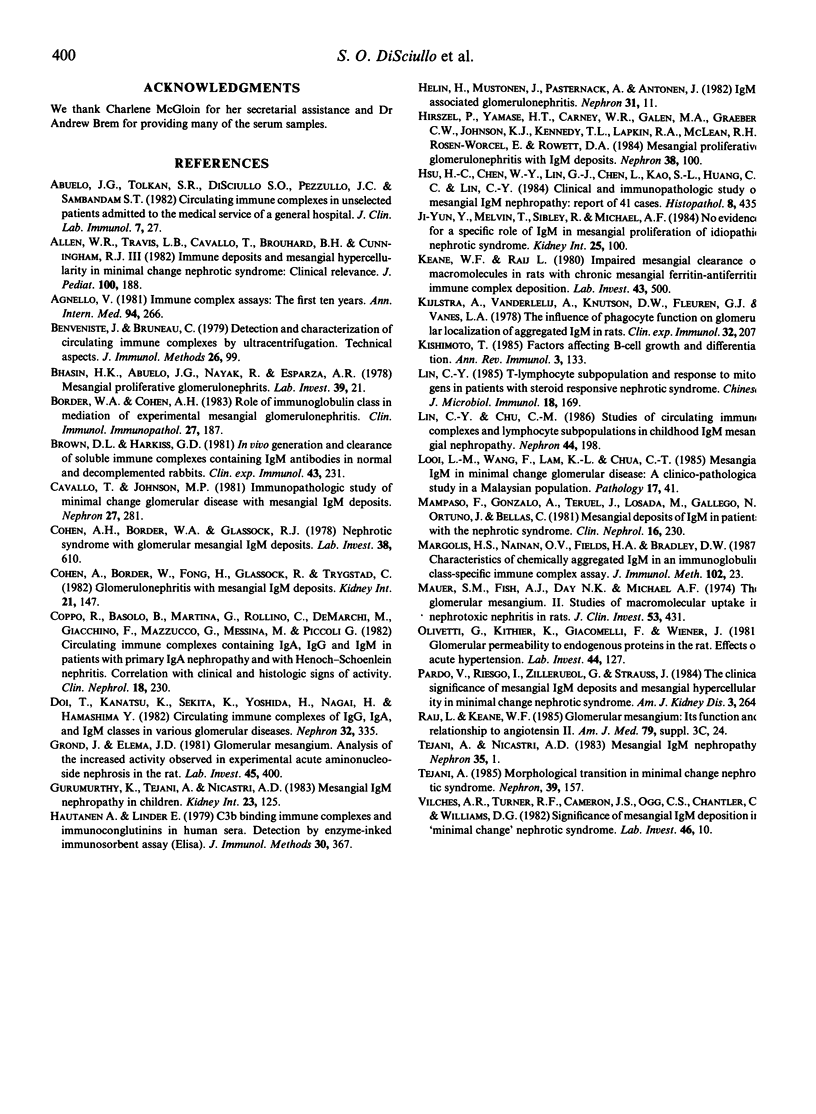
Selected References
These references are in PubMed. This may not be the complete list of references from this article.
- Abuelo J. G., Tolkan S. R., DiSciullo S. O., Pezzulo J. C., Sambandam S. T. Circulating immune complexes in unselected patients admitted to the medical service of a general hospital. J Clin Lab Immunol. 1982 Jan;7(1):27–32. [PubMed] [Google Scholar]
- Agnello V. Immune complex assays: the first ten years. Ann Intern Med. 1981 Feb;94(2):266–267. doi: 10.7326/0003-4819-94-2-266. [DOI] [PubMed] [Google Scholar]
- Allen W. R., Travis L. B., Cavallo T., Brouhard B. H., Cunningham R. J., 3rd Immune deposits and mesangial hypercellularity in minimal change nephrotic syndrome: clinical relevance. J Pediatr. 1982 Feb;100(2):188–191. doi: 10.1016/s0022-3476(82)80632-x. [DOI] [PubMed] [Google Scholar]
- Benveniste J., Bruneau C. Detection and characterization of circulating immune complexes by ultracentrifugation. Technical aspects. J Immunol Methods. 1979;26(2):99–112. doi: 10.1016/0022-1759(79)90074-7. [DOI] [PubMed] [Google Scholar]
- Bhasin H. K., Abuelo J. G., Nayak R., Esparza A. R. Mesangial proliferative glomerulonephritis. Lab Invest. 1978 Jul;39(1):21–29. [PubMed] [Google Scholar]
- Border W. A., Cohen A. H. Role of immunoglobulin class in mediation of experimental mesangial glomerulonephritis. Clin Immunol Immunopathol. 1983 May;27(2):187–199. doi: 10.1016/0090-1229(83)90069-7. [DOI] [PubMed] [Google Scholar]
- Brown D. L., Harkiss G. D. In vivo generation and clearance of soluble immune complexes containing IgM antibodies in normal and decomplemented rabbits. Clin Exp Immunol. 1981 Feb;43(2):231–239. [PMC free article] [PubMed] [Google Scholar]
- Cavallo T., Johnson M. P. Immunopathologic study of minimal change glomerular disease with mesangial IgM deposits. Nephron. 1981;27(6):281–284. doi: 10.1159/000182071. [DOI] [PubMed] [Google Scholar]
- Cohen A. H., Border W. A., Glassock R. J. Nehprotic syndrome with glomerular mesangial IgM deposits. Lab Invest. 1978 May;38(5):610–619. [PubMed] [Google Scholar]
- Coppo R., Basolo B., Martina G., Rollino C., De Marchi M., Giacchino F., Mazzucco G., Messina M., Piccoli G. Circulating immune complexes containing IgA, IgG and IgM in patients with primary IgA nephropathy and with Henoch-Schoenlein nephritis. Correlation with clinical and histologic signs of activity. Clin Nephrol. 1982 Nov;18(5):230–239. [PubMed] [Google Scholar]
- Doi T., Kanatsu K., Sekita K., Yoshida H., Nagai H., Hamashima Y. Circulating immune complexes of IgG, IgA, and IgM classes in various glomerular diseases. Nephron. 1982;32(4):335–341. doi: 10.1159/000182875. [DOI] [PubMed] [Google Scholar]
- Grond J., Elema J. D. Glomerular mesangium. Analysis of the increased activity observed in experimental acute aminonucleoside nephrosis in the rat. Lab Invest. 1981 Nov;45(5):400–409. [PubMed] [Google Scholar]
- Hautanen A., Linder E. C3b binding immune complexes and immunoconglutinins in human sera. Detection by enzyme-linked immunosorbent assay (ELISA). J Immunol Methods. 1979;30(4):367–380. doi: 10.1016/0022-1759(79)90019-x. [DOI] [PubMed] [Google Scholar]
- Helin H., Mustonen J., Pasternack A., Antonen J. IgM-associated glomerulonephritis. Nephron. 1982;31(1):11–16. doi: 10.1159/000182598. [DOI] [PubMed] [Google Scholar]
- Hirszel P., Yamase H. T., Carney W. R., Galen M. A., Graeber C. W., Johnson K. J., Kennedy T. L., Lapkin R. A., McLean R. H., Rosenworcel E. Mesangial proliferative glomerulonephritis with IgM deposits. Clinicopathologic analysis and evidence for morphologic transitions. Nephron. 1984;38(2):100–108. doi: 10.1159/000183289. [DOI] [PubMed] [Google Scholar]
- Hsu H. C., Chen W. Y., Lin G. J., Chen L., Kao S. L., Huang C. C., Lin C. Y. Clinical and immunopathologic study of mesangial IgM nephropathy: report of 41 cases. Histopathology. 1984 May;8(3):435–446. doi: 10.1111/j.1365-2559.1984.tb02355.x. [DOI] [PubMed] [Google Scholar]
- Ji-Yun Y., Melvin T., Sibley R., Michael A. F. No evidence for a specific role of IgM in mesangial proliferation of idiopathic nephrotic syndrome. Kidney Int. 1984 Jan;25(1):100–106. doi: 10.1038/ki.1984.14. [DOI] [PubMed] [Google Scholar]
- Keane W. F., Raij L. Impaired mesangial clearance of macromolecules in rats with chronic mesangial ferritin-antiferritin immune complex deposition. Lab Invest. 1980 Dec;43(6):500–508. [PubMed] [Google Scholar]
- Kijlstra A., Van Der Lelij A., Knutson W., Fleuren G. J., Vanes L. A. The influence of phagocyte function on glomerular localization of aggregated IgM in rats. Clin Exp Immunol. 1978 May;32(2):207–217. [PMC free article] [PubMed] [Google Scholar]
- Kishimoto T. Factors affecting B-cell growth and differentiation. Annu Rev Immunol. 1985;3:133–157. doi: 10.1146/annurev.iy.03.040185.001025. [DOI] [PubMed] [Google Scholar]
- Lin C. Y., Chu C. M. Studies of circulating immune complexes and lymphocyte subpopulations in childhood IgM mesangial nephropathy. Nephron. 1986;44(3):198–203. doi: 10.1159/000183986. [DOI] [PubMed] [Google Scholar]
- Looi L. M., Wang F., Lam K. L., Chua C. T. Mesangial IGM in minimal change glomerular disease: a clinicopathological study in a Malaysian population. Pathology. 1985 Jan;17(1):41–44. doi: 10.3109/00313028509063722. [DOI] [PubMed] [Google Scholar]
- Mampaso F., Gonzalo A., Teruel J., Losada M., Gallego N., Ortuno J., Bellas C. Mesangial deposits of IgM in patients with the nephrotic syndrome. Clin Nephrol. 1981 Nov;16(5):230–234. [PubMed] [Google Scholar]
- Mauer S. M., Fish A. J., Day N. K., Michael A. F. The glomerular mesangium. II. Studies of macromolecular uptake in nephrotoxic nephritis in rats. J Clin Invest. 1974 Feb;53(2):431–439. doi: 10.1172/JCI107577. [DOI] [PMC free article] [PubMed] [Google Scholar]
- Olivetti G., Kithier K., Giacomelli F., Wiener J. Glomerular permeability to endogenous proteins in the rat: effects of acute hypertension. Lab Invest. 1981 Feb;44(2):127–137. [PubMed] [Google Scholar]
- Pardo V., Riesgo I., Zilleruelo G., Strauss J. The clinical significance of mesangial IgM deposits and mesangial hypercellularity in minimal change nephrotic syndrome. Am J Kidney Dis. 1984 Jan;3(4):264–269. doi: 10.1016/s0272-6386(84)80043-8. [DOI] [PubMed] [Google Scholar]
- Vilches A. R., Turner D. R., Cameron J. S., Ogg C. S., Chantler C., Williams D. G. Significance of mesangial IgM deposition in "minimal change" nephrotic syndrome. Lab Invest. 1982 Jan;46(1):10–15. [PubMed] [Google Scholar]


